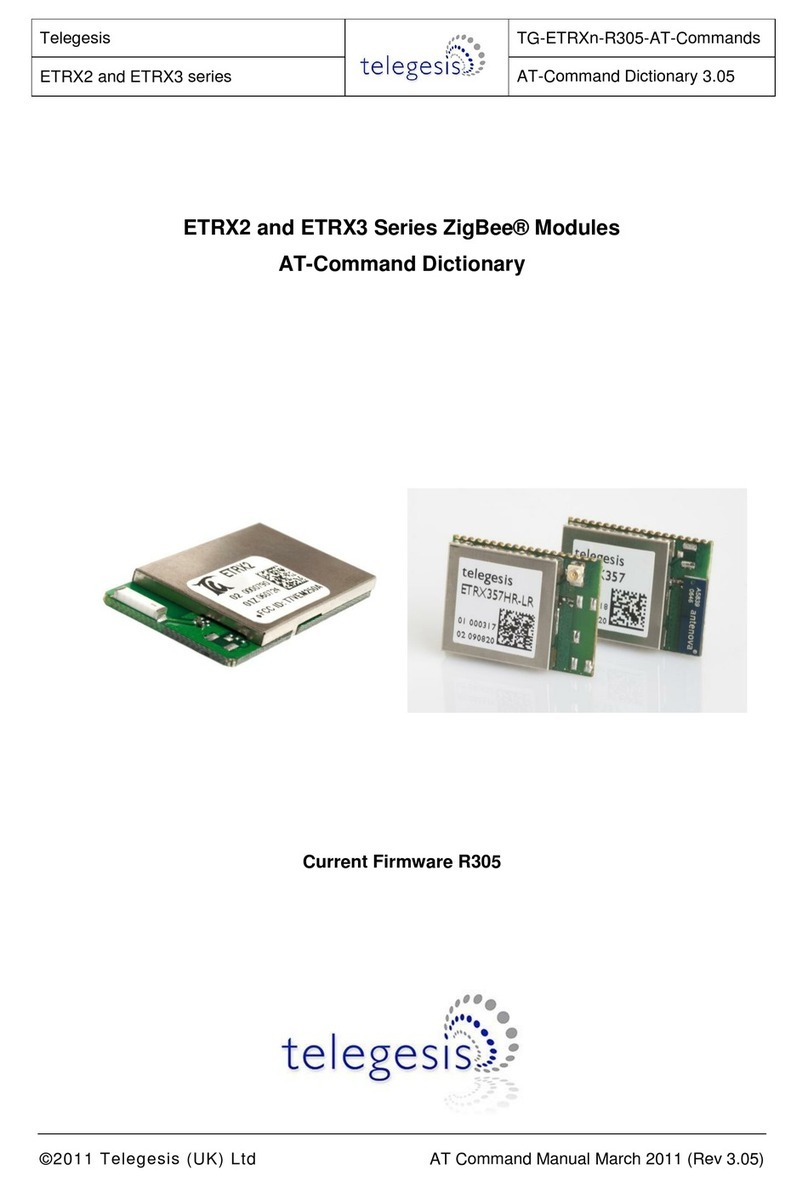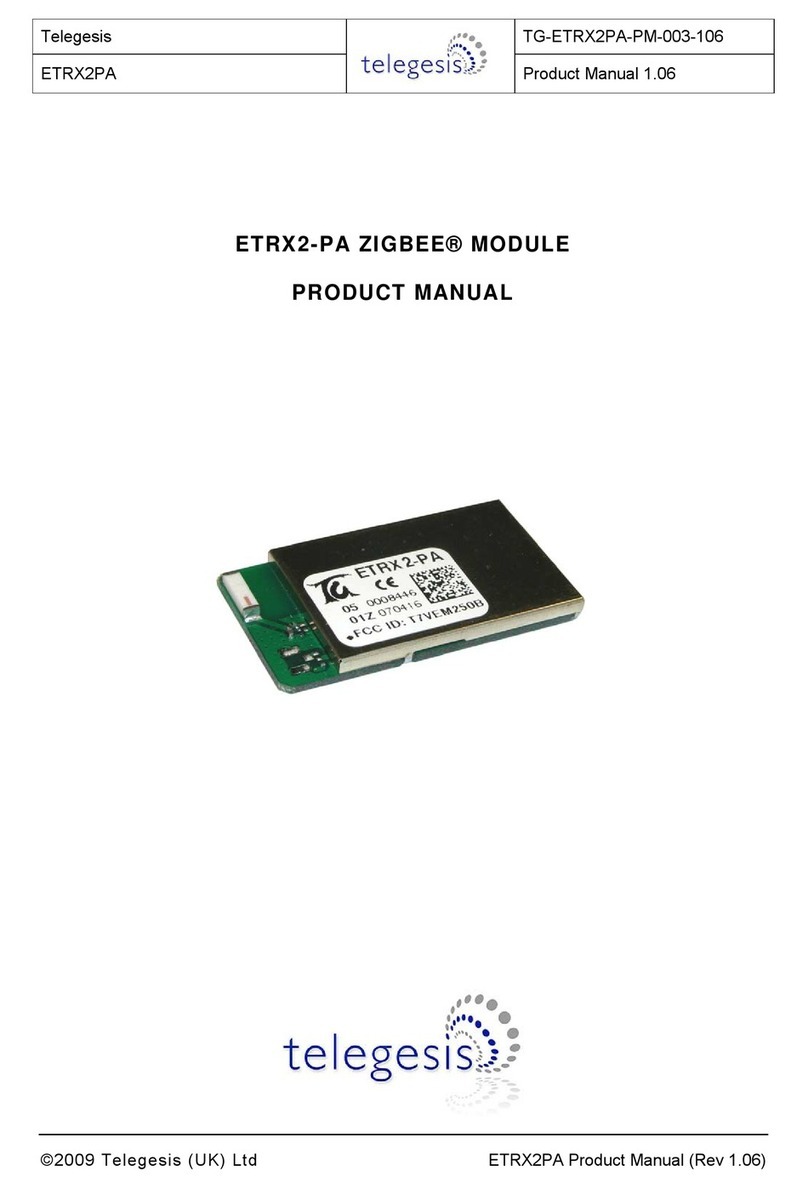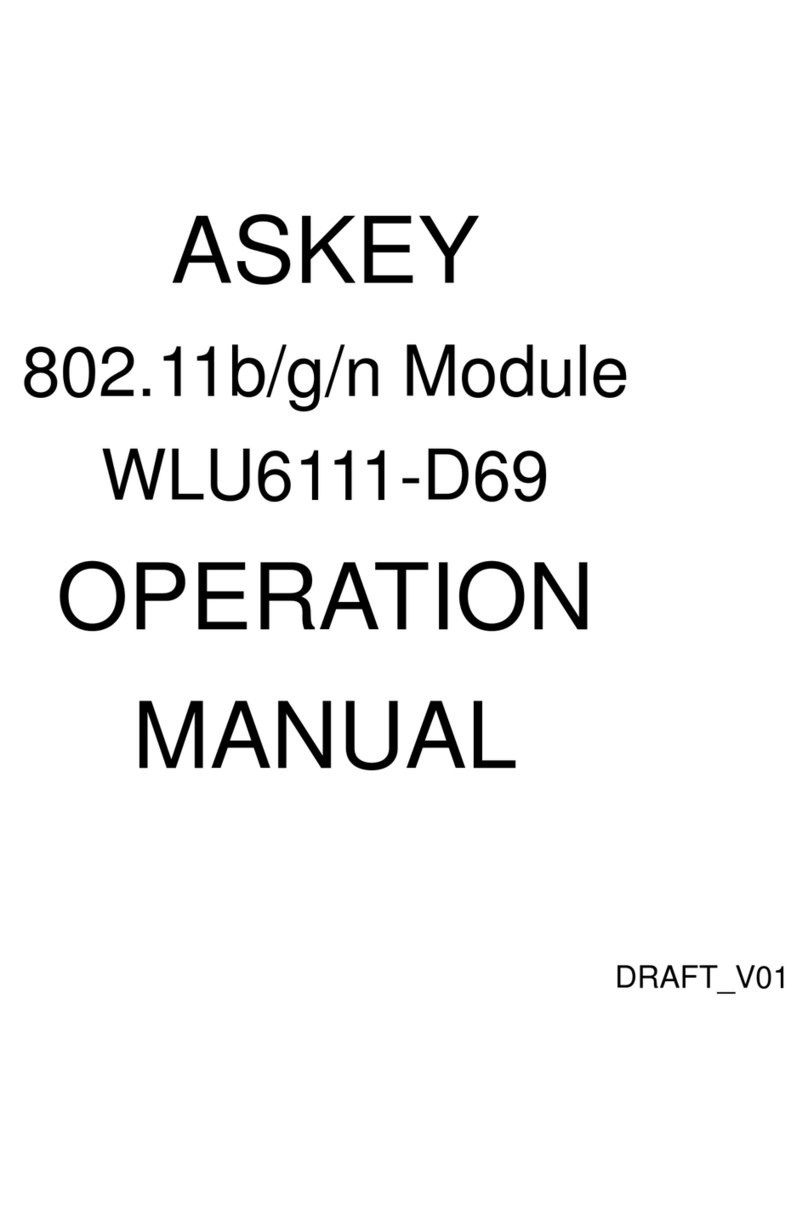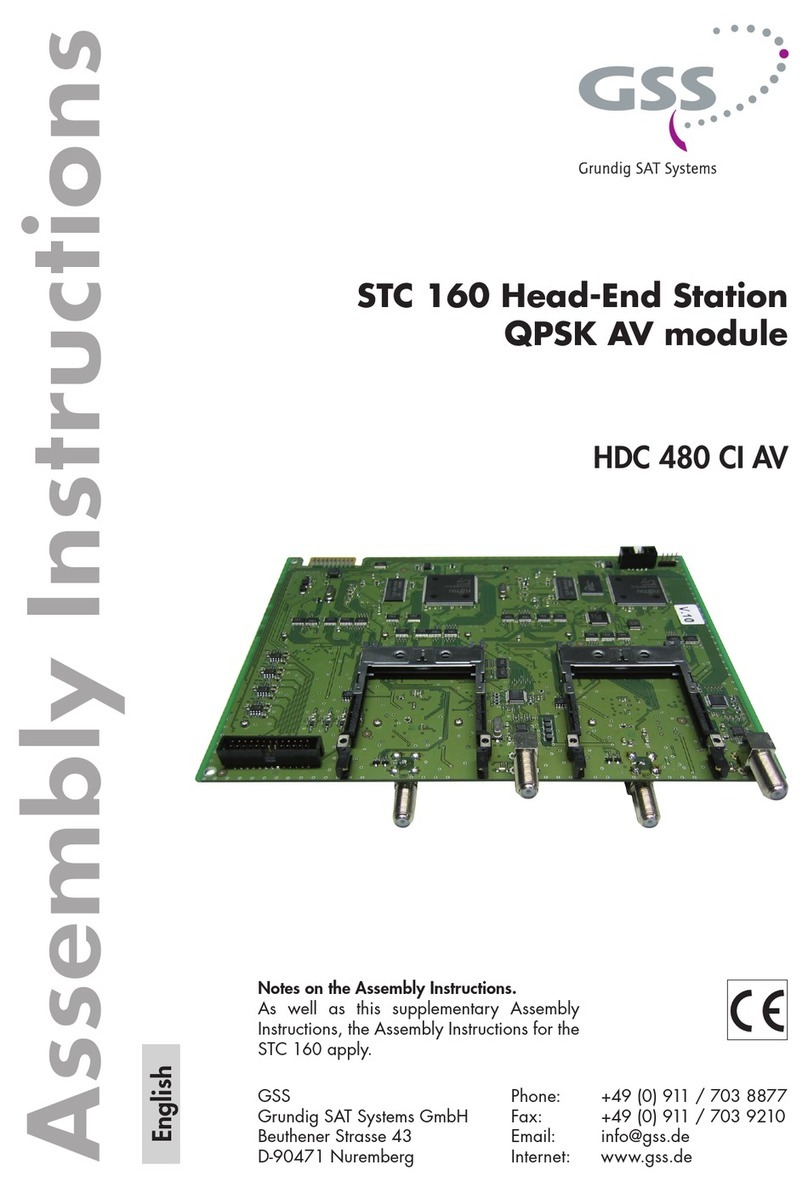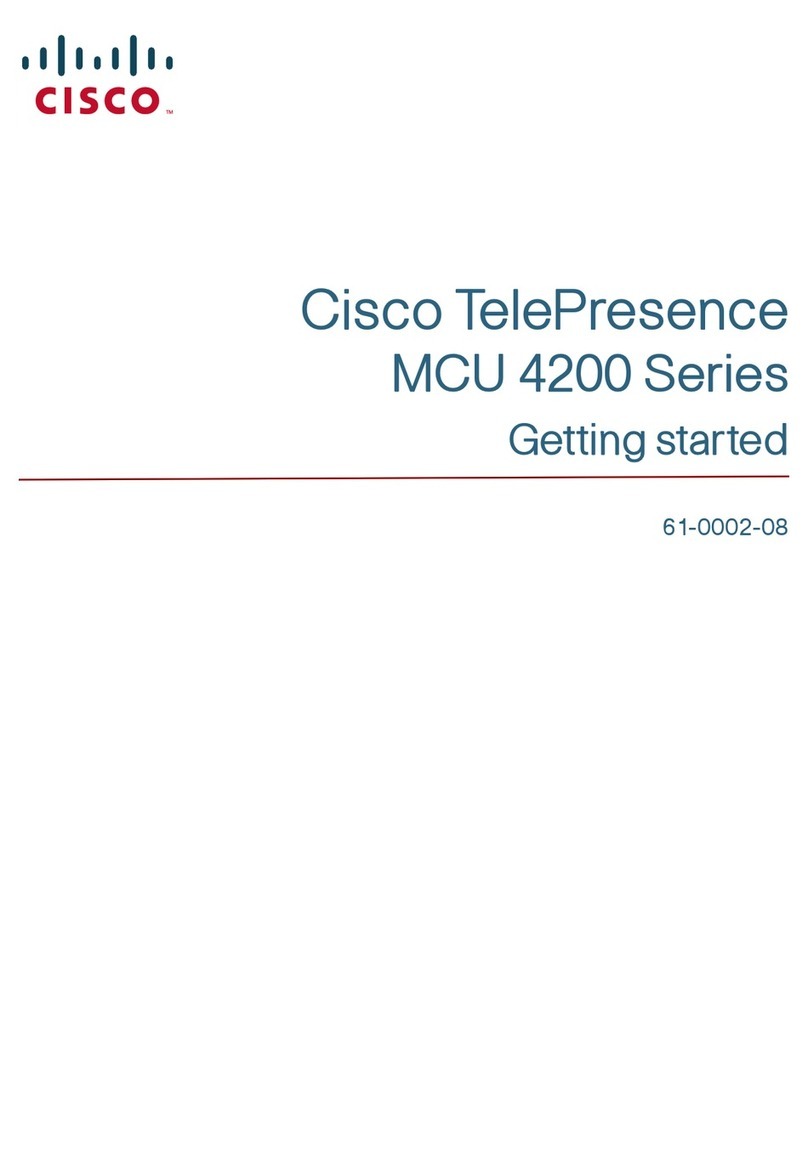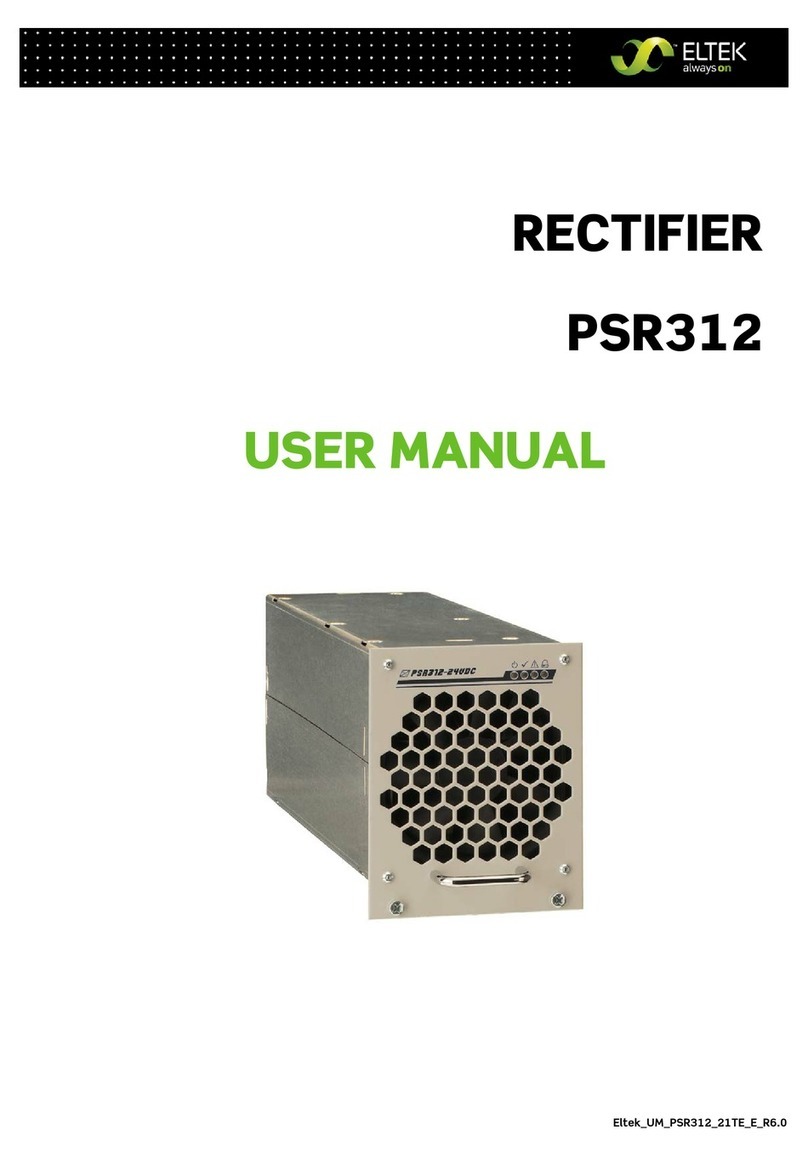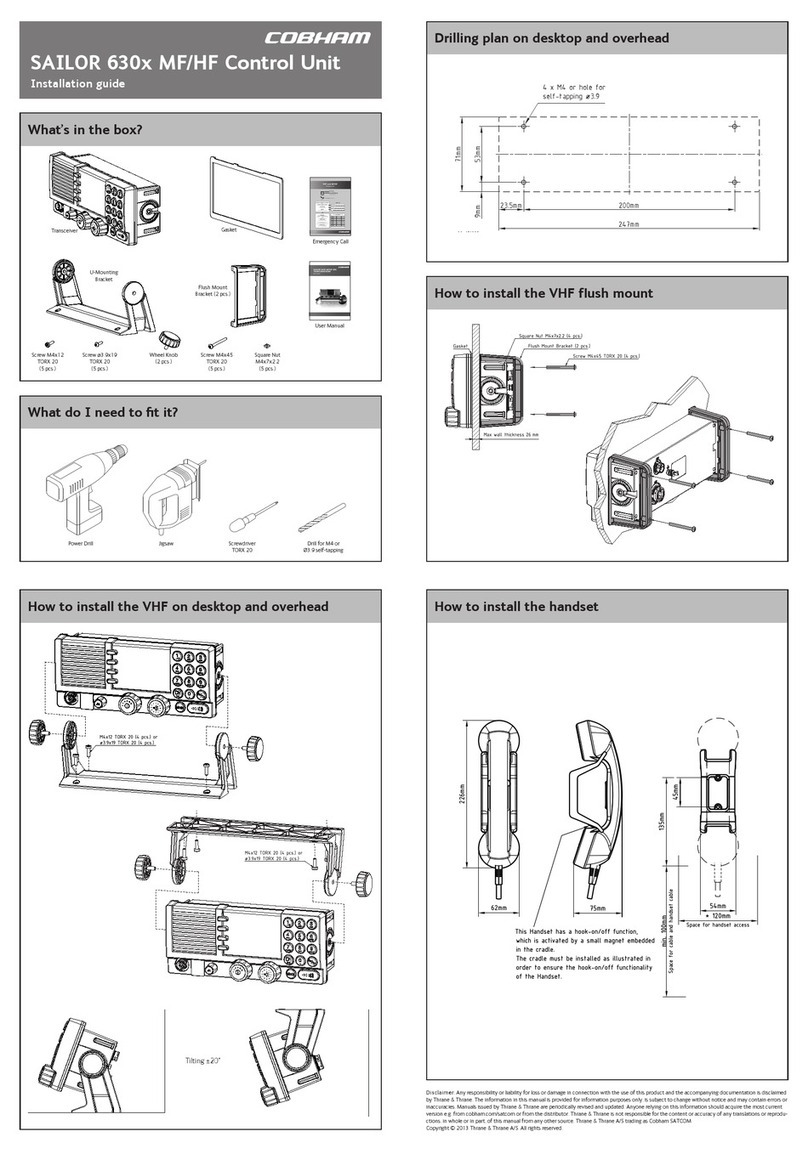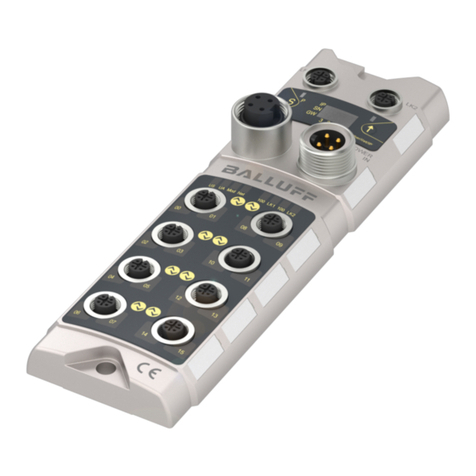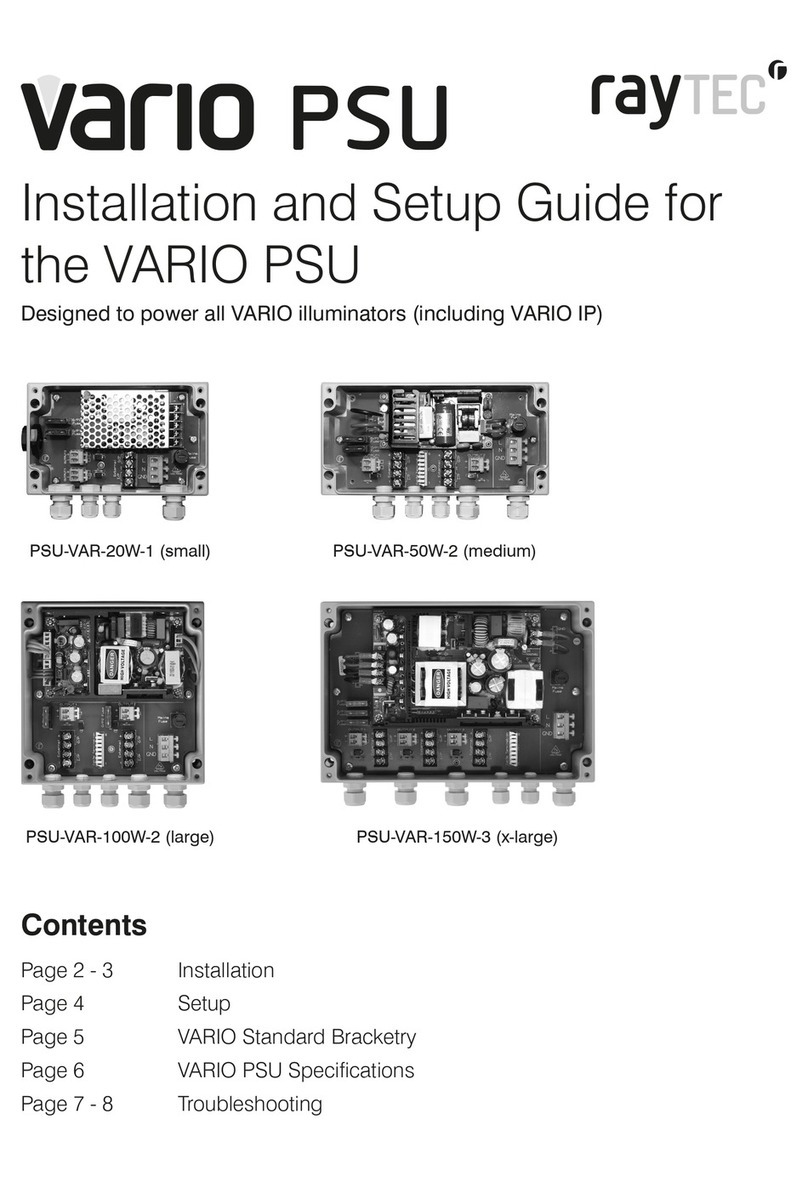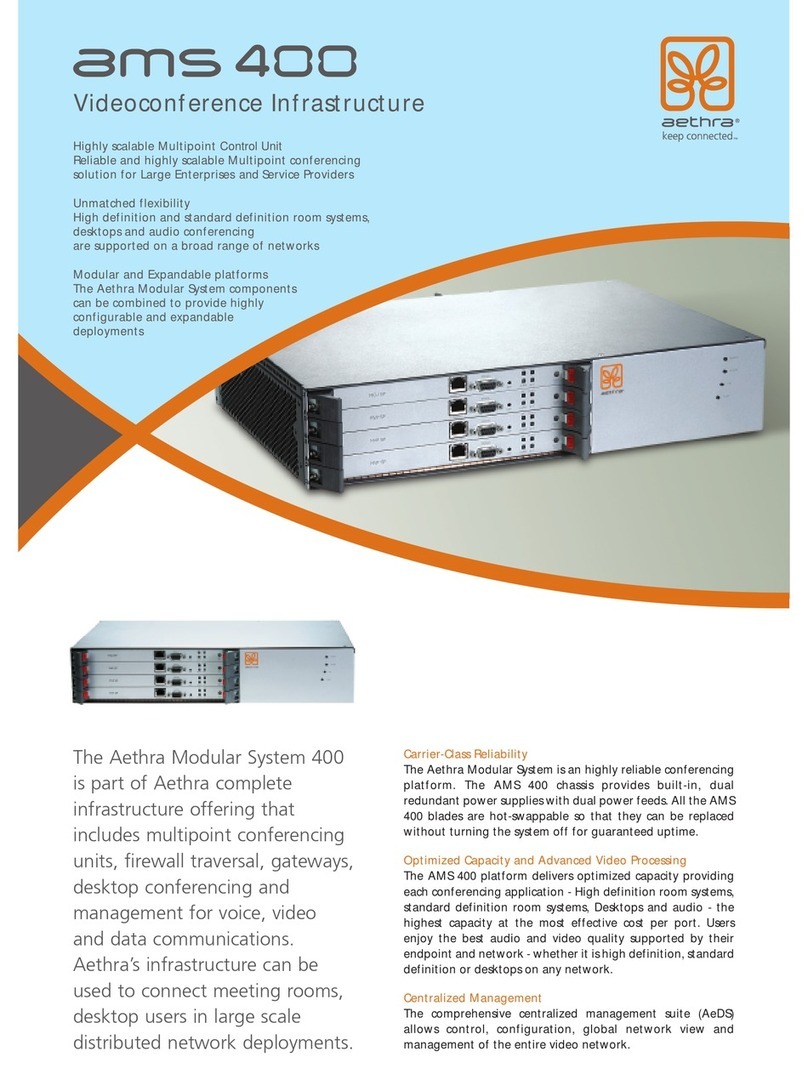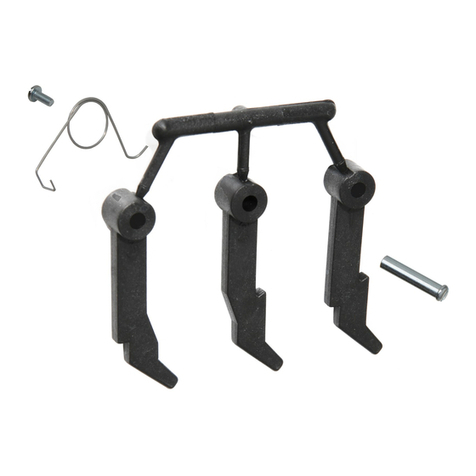Telegesis ETRX357-LR Installation instructions

Telegesis
TG-ETRXn-R309-AT-Commands
ETRX3 series
AT-Command Dictionary 3.09
©2015 Telegesis (UK) Ltd AT Command Manual July 2015 (Rev 3.09)
ETRX3 Series ZigBee Module
AT-Command Dictionary
Firmware R309
EmberZNet 5.4.0 stack

R309 AT Commands
©2015 Telegesis (UK) Ltd - 2 - AT Command Manual (Rev 3.09)
Table of Contents
1INTRODUCTION.................................................................................................................4
1.1 The first step....................................................................................................................4
1.2 Module overview..............................................................................................................4
1.3 Document Overview.........................................................................................................4
1.4 Network topology .............................................................................................................5
1.5 The ADCs ........................................................................................................................5
1.6 RTC Related Commands.................................................................................................5
1.7 A Note on ZigBee®Compliance .......................................................................................5
1.8 Important notes................................................................................................................6
1.8.1 Hardware compatibility.....................................................................................................6
1.8.2 Unexpected start-up in bootloader mode..........................................................................6
1.8.3 Compatibility with other devices.......................................................................................6
1.8.4 Persistence of network parameters..................................................................................6
2AT STYLE COMMAND CONVENTIONS............................................................................7
2.1 Parameters ......................................................................................................................8
2.2 Prompt Overview..............................................................................................................9
2.3 Device Overview............................................................................................................11
2.3.1 ZigBee types..................................................................................................................11
2.3.2 Non-ZigBee types ..........................................................................................................11
2.4 Addressing modes .........................................................................................................11
2.5 AT Command Overview.................................................................................................13
2.6 Module Control & Configuration Commands ..................................................................15
2.7 Network Control & Configuration Commands.................................................................21
2.8 Messaging......................................................................................................................40
2.9 Binding Management (ETRX3 Series only)....................................................................58
2.10 Time-related commands.................................................................................................63
3LIST OF ERROR CODES.................................................................................................65
4S-REGISTERS..................................................................................................................67
4.1 Recovery of the Factory Default Settings.......................................................................69
4.2 S-Registers for Network Setup.......................................................................................70
4.3 S-Registers for Module Setup ........................................................................................75
4.4 I/O related S-Registers...................................................................................................81
4.5 S-Registers Defining the Functionality of the Module .....................................................90
4.6 Advanced Settings.......................................................................................................104
5BUILD IN FUNCTIONALITY ...........................................................................................112
6ETRX357 POWER CONSUMPTION (PROVISIONAL DATA) ........................................115
7NOTES ON ENERGY LEVELS AND LQI .......................................................................116
7.1 Interpreting LQI............................................................................................................116
7.2 Interpreting RSSI Energy Levels..................................................................................117
8TRADEMARKS...............................................................................................................118
9DISCLAIMER..................................................................................................................118
10 CONTACT INFORMATION.............................................................................................118

R309 AT Commands
©2015 Telegesis (UK) Ltd - 3 - AT Command Manual (Rev 3.09)
11 REFERENCES................................................................................................................118
12 APPENDIX A. FORMING A SECURE NETWORK ........................................................119
13 APPENDIX B. BOOTLOADING NEW FIRMWARE .......................................................120
13.1 Bootloading through the serial port...............................................................................120
13.2 Bootloading over the air ...............................................................................................121

R309 AT Commands
©2015 Telegesis (UK) Ltd - 4 - AT Command Manual (Rev 3.09)
1 Introduction
1.1 The first step
Send the command “ATI” to a module to find its firmware version. If it is not R309 then you should
refer to the correct version of the AT command manual, or send an e-mail to
zigbeesupport@telegesis.com requesting a copy of the R309 firmware file. All four variants of the
ETRX357 module share the same file.
Alternatively if your module has R309 and you prefer a different version, this can be provided on
request.
All the standard AT command set firmware files are free of charge to users who already have the
ETRXn devices, but they must only be used on Telegesis modules.
1.2 Module overview
This document describes the AT-Command interface firmware of the ETRX3 series ZigBee PRO
wireless meshing modules. It applies to the R309 firmware, which can be loaded on to all products
of the ETRX3 module series, for example:
- ETRX357, ETRX357-LR, ETRX357-LRS
- ETRX357HR, ETRX357HR-LR, ETRX357HR-LRS
- ETRX3585, ETRX3587 and ETRX3588
- ETRX3USB
- ZigBee Communications Gateway
The Telegesis ZigBee modules have been designed to be built into any device and provide a low
cost, low power ZigBee solution based on the industry leading EmberZNet ZigBee stack.
Integration into a wide range of applications is made easy using a simple AT-style software
interface and advanced hardware design.
No RF experience or expertise is required to add this powerful wireless networking capability to
your products. Telegesis ZigBee modules offer fast integration opportunities and the shortest
possible time to market for your product.
Important note
Using the AT-Command interface described in this document can shorten the time to market
significantly, however customers using the range of Telegesis modules also have the option of
using Ember’s EZSP interface firmware or of developing custom firmware using the Ember
Development tools.
1.3 Document Overview
This document is meant as an AT-Command and S-Register reference for R3xx revisions of the
firmware based on EmberZNet3.x and EmberZNet4.x. In order to learn how your products can
benefit from wireless mesh networking please also refer to the following documents:
ETRX3 Product Manuals

R309 AT Commands
©2015 Telegesis (UK) Ltd - 5 - AT Command Manual (Rev 3.09)
R3xx Firmware User Guide
Migration guide for existing R2xx firmware customers
ETRX3 Development Kit User Guides
Application notes from www.telegesis.com
The ETRX3 Product Manuals concentrate on the hardware specification of the modules. The
Development Kit Product Manuals contain all of the information required to set up your
development kit and run firmware upgrades where necessary.
1.4 Network topology
A network consists of a ZigBee Coordinator (ZC) which started the network, ZigBee Routers (ZR)
and ZigBee End Devices (ZED). There do not have to be any routers (other than the coordinator,
which functions as a router) or end devices in any given network. Each router can support up to
30 end devices in any combination of non-sleepy, sleepy and mobile End Devices. The network is
always formed as a mesh according to the ZigBee PRO featureset of the ZigBee standard; the tree
structure is not available.
By default the module joins a PAN as a router, but modifying register S0A allows you to define it as
an end device. The coordinator is simply the device that first establishes the PAN, and it should
not be allowed to leave the PAN as it is not possible for a node that is already joined to the PAN to
take over the role of a coordinator or Trust Centre.
1.5 The ADCs
The ETRX357 can operate up to 4 ADCs, which are individually enabled by settng the appropriate
bits in register S15. A reading is taken each time one of the registers S1F-22 is read, or when a
built-in function is executed which reads an ADC. If bit 8 of S15 is set the 1.2V Vref level is
presented at pin PB0 for the brief interval while the reading is taken.
Mode: single-ended
Range: 0-1200mV
Resolution: 14 bits
Units: 1 LSB = 0.1mV
Max load on PB0: 1mA
1.6 RTC Related Commands
The module runs a real time clock which can be set, read and synchronized against a time server
with the commands shown in this chapter. Please note that the basis of the real time clock is an
on-chip RC timer which gets calibrated against the external quartz crystal. Overall the accuracy is
not high and will vary with temperature, so if an accurate RTC is to be maintained frequent re-
synchronization with a time server is required.
1.7 A Note on ZigBee®Compliance
The Telegesis R300 firmware has been tested and certified for MSP (manufacturer specific profile)
compliance by a test house appointed by the ZigBee Alliance.

R309 AT Commands
©2015 Telegesis (UK) Ltd - 6 - AT Command Manual (Rev 3.09)
This certification includes tests guaranteeing that:
-Modules running the Telegesis AT-Command set will not interfere with existing ZigBee
Networks in a malicious way
-Modules running the Telegesis AT-Command set can join a 3rd party ZigBee PRO network
and use its routing capabilities
-Modules running the Telegesis AT-Command set can allow 3rd party nodes to join into a
network consisting of Telegesis nodes and use its routing capabilities
In addition to implementing a manufacturer specific application profile the AT-Command set allows
for transparency allowing communication with 3rd party nodes running any public application
profile. In addition to this a transparent endpoint has been added allowing a host processor to
implement any public application profile in fully transparent mode.
If you want to use the term ZigBee or the ZigBee Logo in your product documentation the current
regulations state that you have to
(i) Be at least an adopting member of the ZigBee Alliance in the year you release your product
(ii) Implement a public application profile
If you intend to get your product certified feel free to contact Telegesis for additional information.
Also if you intend to build a product compliant to a public application profile (e.g. Home
Automation, Smart Energy) feel free to contact us to discuss your options.
1.8 Important notes
1.8.1 Hardware compatibility
R2xx firmware will not run on the ETRX3 series of modules.
1.8.2 Unexpected start-up in bootloader mode
The bootloader in the ETRX357 can be triggered using the command AT+BLOAD as described in
section 2, but it can also be triggered in hardware. If the PA5 pin is pulled low during the boot-up
of the module, the module will also enter the bootloader, so exercise caution when doing hardware
design and ensure that this pin is not grounded during start-up and reset. If unused the pad can
be left floating and a pull-up is not required.
1.8.3 Compatibility with other devices
Most features of the R3xx Telegesis AT-Command line Interpreter are part of a Manufacturer
Specific Profile using the ZigBee PRO feature set of ZigBee 2007. Interoperability with other
devices that use the ZigBee PRO featureset is limited to a number of transparent commands.
R3xx is not compatible with earlier versions of ZigBee which do not implement the ZigBee PRO
featureset, including Telegesis R2xx firmware. Also, it is not compatible with the ZigBee Smart
Energy profile as it lacks the required security key.
1.8.4 Persistence of network parameters
Once a device has joined a network as a coordinator, router or end device, it will retain its network
parameters if it is powered off and on again. It will still be a member of its original PAN, assuming
that PAN still exists, though an end device may need to find a new parent and it may have missed
an update of the network key. Certain S-registers will have been reset to default values, though,
which may change an end device’s power mode for example.

R309 AT Commands
©2015 Telegesis (UK) Ltd - 7 - AT Command Manual (Rev 3.09)
2 AT Style Command Conventions
To simplify the communication with the modules, an AT-style command set, similar to the industry
standard Hayes modem control language, is used.
Each command must be preceded by the "AT" or "at" prefix. To terminate a command enter
<CR>. Any data not following this pattern is either not accepted by the module or will cause an
error message in response. Every command must be terminated with a <CR>, they cannot be
concatenated.
Commands are followed by an optional response that includes <CR><LF><Response><CR><LF>
and/or a prompt <CR><LF><Prompt><CR><LF> where the prompt could also be an error
message.
Example:
ATS00?<CR>
<CR><LF>FFFF<CR><LF>
<CR><LF>OK<CR><LF>
It is recommended to wait for an “OK” or “ERROR:XX” prompt before issuing the next command.
Any data which is prompted to the user is delivered in the format <CR><LF><prompt><CR><LF>.
Unless disabled in S0E or S0F prompts may appear whenever the corresponding event occurs.
Example:
<CR><LF><BCAST:000D6F000005A666,04=test><CR><LF>
A prompt intersecting a command being entered will not affect the command itself.
Throughout this document, only the responses and prompts are presented, <CR><LF> are omitted
intentionally. Sequences of AT commands in a single line are not supported.
The ETRX357 features a 128-byte FIFO to buffer incoming characters from the host processor,
which is sufficient to hold even the longest possible command. The ETRX357 features a 256-byte
FIFO buffer for incoming radio messages, which allows rapid reception of multiple messages
without loss of characters. To prevent a buffer overflow XON/XOFF handshaking is used. Optional
hardware handshaking can be enabled as described in the register description of S12 in section 4.
Read Command
ATXXX?
Commands ending with a ‘?’ return the currently set value of the
parameter or parameters
Write Command
ATXXX=<…>
This command sets user-definable parameters as indicated by
the ‘=’ sign.
Execute Command
ATXXX
This command executes routines of the module and returns
parameters
Table 1: Types of AT commands
When bit 7 of S12 is set each individual reply or prompt is additionally started with the STX and
ended with the ETX character to aid the interpretation of the incoming strings on a host processor.

R309 AT Commands
©2015 Telegesis (UK) Ltd - 8 - AT Command Manual (Rev 3.09)
2.1 Parameters
Each parameter must be entered in the correct format for any of the AT commands to execute
correctly. Optional parameters are marked with square brackets […].
XX
8-bit hexadecimal number. Valid characters are 0-9, a-f and A-F
XXXX
16-bit hexadecimal number. Valid characters are 0-9, a-f and A-F
n
Number from 0-9
s
Sign
b
Bit (0 or 1)
c
character
<PID>
16-bit hexadecimal PAN ID (0000 to FFFF)
<EPID>
64-bit hexadecimal extended PAN ID
<channel>
decimal channel (802.15.4 channel 11-26)
<password>
8 character password
<EUI64>
64-bit IEEE 802.15.4 address in hexadecimal
<ioread>
32-bit hexadecimal number representing the reading of S1A
<data>
Custom Data
<ClusterList>
A list of 16 bit cluster identifiers in hexadecimal representation
<FirmwareRevision>
The Firmware Revision Number
Table 2: Different formats of parameters

R309 AT Commands
©2015 Telegesis (UK) Ltd - 9 - AT Command Manual (Rev 3.09)
2.2 Prompt Overview
The following prompts can show up during the operation of the ETRX357 modules. Most of the
prompts can be disabled using register S0E and S0F.
Prompt Overview
OK
OK terminator
ERROR:XX
Error number XX occurred
ACK:XX
Acknowledgement for message XX was received
NACK:XX
Acknowledgement for message XX was not
received
POLLED:XX
Shown on an end device when it polls its parent
and S11 bit D is set. XX codes are:
00 - Success
31 - no data pending on host
66 - poll could not be executed
40 - no ack from parent
SR:XX,<EUI64>,<NWK addr>,…
Route Record Message received
BCAST:[<EUI64>,]XX=<data>
[,<RSSI>,<LQI>]
A Broadcast with XX characters has been
received
MCAST:[<EUI64>,]XX=<data>
[,<RSSI>,<LQI>]
A Multicast with XX characters has been received
UCAST:[<EUI64>,]XX=<data>
[,<RSSI>,<LQI>]
A Unicast with XX characters has been received
INTERPAN:<ProfileID>,<ClusterID>,
<Msgtype>,<Option>,[GroupID],<PanID>,
<SrcAddr>,<MsgLength>,<Msg>
The device has received an interpan message
<ProfileID> - 16 bit hex
<ClusterID> - 16 bit hex
<Msgtype> - 8 bit hex
0x00 –Unicast
0x08 –Broadcast
0x0C- Multicast
<Option> - 16 bit hex. If it is 0x0002 the
<SrcAddr> will be source long address, and
otherwise it is source network address
[GroupID] –16 bit hex, shown if the message is
sent to a group
<PanID> - 16 bit hex, source PAN ID
<SrcAddr> - 16 bit hex source node ID or EUI
<MsgLength> - 8 bit hex, message length
<Msg> - received message in hex format
RAW:snn,<data>
A raw message has been received with strength
snn dBm
SDATA:[<EUI64>,],<ioread>,<ADC0>,
<ADC1>,<sequenceNo>,<Vcc>
A data message has been received at the sink.
ADC data is ADC0 & ADC1

R309 AT Commands
©2015 Telegesis (UK) Ltd - 10 - AT Command Manual (Rev 3.09)
Prompt Overview
FN130:[<EUI64>],<NWK addr>,<ioread>,
<sequence no>,<S46>,[<ADC0>],
[<ADC1>],[<ADC3>],[<ADC3>]
A data message has been received at the sink.
The number of ADC data fields depends on how
many ADCs are activated at the sender
FFD:<EUI64>,<NWK addr>
A router announcing itself
SED:<EUI64>,<NWK addr>
A sleepy end device announcing itself
MED:<EUI64>,<NWK addr>
A mobile sleepy end device announcing itself
ZED:<EUI64>,<NWK addr>
An end device announcing itself
NEWNODE: <NWK addr>,<EUI64>,
<Parent NWK addr>
Shown on Coordinator: New node has been given
permission to join the PAN. NB joining is not
complete until an “FFD” prompt or similar is
received
LeftPAN
Local Node has left the PAN
LostPAN
End Device has lost contact with Parent
JPAN:<channel>,<PID>,<EPID>
Local Node has joined PAN with given parameters
NODELEFT: <NWK addr>,<EUI64>
A device has left the PAN (shown on COO only)
ADSK:<EUI64>,<NWK addr>
Received Sink Advertisement
SREAD:<NWK addr>,<EUI64>,<Register>,
<errorcode>[=<Data>]
Reply to a remote S Register Read operation
SWRITE:<NWK addr>,<EUI64>,<errorcode>
Reply to a remote S Register Write operation
Bind:<NWK addr>,<status>
Create Binding Status
Unbind:<NWK addr>,<status>
Delete Binding Status
End Device Bind:<NWK addr>,<status>
End device binding status
DataMODE:<NWK addr>,<EUI64>
Datamode has been opened remotely
DataMODE:<NWK addr>,<EUI64>,
<errorcode>
Response to an attempt to open data mode
OPEN
Data mode is open
CLOSED
Data mode is closed
TRACK:<EUI64 R>,<EUI64 S>,<RSSI>,
<i/o read>,<ADC0>,<ADC1>,<Vcc>,<S46>
Tracking message: EUIs of receiver and sender,
RSSI, input data, Vcc & S46 counter of sender
(only the low-order 16 bits of S46 are shown)
TRACK2:<EUI64 R>,<EUI64 S>,<RSSI>,
<I/O read>,<S46>
Tracking message: EUIs of receiver and sender,
RSSI, I/O data, and S46 counter of sender
PWRCHANGE:XXXX
Local node has changed Power Mode to XXXX
AddrResp:<errorcode>
[,<NWK addr>,<EUI64>]
Response to an address request (also triggered
when finding source routes)
RX:<EUI64>,<NWK addr>,<profileID>,
<destinationEndpoint>,<SourceEndpoint>,
<clusterID>,<length>:<payload>
[,<RSSI>,<LQI>]
An incoming message not addressed to the AT
command endpoint. EUI64 is only shown if
included in network frame header
NM:ES REPORT WARNING
More than 16 energy scan reports have been
recently received by the network manager
indicating high packet loss
ENTERING BLOAD
Passthrough bootloading has been initiated from
another node
Table 3: Prompt Overview

R309 AT Commands
©2015 Telegesis (UK) Ltd - 11 - AT Command Manual (Rev 3.09)
2.3 Device Overview
2.3.1 ZigBee types
Table 4 gives an overview of the ZigBee device types mentioned in this document.
Device Types
ZigBee Naming Convention
COO
Coordinator
ZigBee Coordinator (ZC)
FFD
Router
ZigBee Router (ZR)
ZED
End Device (non sleepy)
ZigBee End Device (ZED)
SED
Sleepy End Device
MED
Mobile Sleepy end Device
Table 4: Device Overview
The terms Full Function device (FFD) and Reduced Function Device (RFD) are obsolete, but the
abbreviations are retained in the R309X firmware to avoid problems with users’ legacy application
software.
Each ETRX357 coordinator or router can support up to 30 End Devices, in any combination of
Sleepy End Devices and Mobile End Devices.
Only end devices should be put into a low-power state because routers and the coordinator must
always be powered up to maintain the network connectivity. ZigBee End Devices do not poll for
data, instead their incoming messages are relayed immediately by their parent without being
buffered. This means that ZEDs must not be put into a sleep mode.
2.3.2 Non-ZigBee types
Sink. The sink is a Telegesis feature. When a node is defined as a sink by setting S10 bit 4, it
can broadcast its address to the rest of the network. Other nodes can then send messages to the
sink node using AT+SCAST or various built-in functions. This simplifies the application software
since it is not necessary to know the EUI64 of the sink in advance.
Routers discover the sink when (1) they receive a regular advertisement broadcast from the sink
(2) they are commanded to send a message without knowing the sink address and bit 8 of S10 is
set (the first sink-cast message is therefore lost) (3) the AT+SSINK command is used.
To reduce traffic to end devices they do not receive the advertisement broadcasts and are not
informed of the sink address when they join the PAN. Instead they automatically search for the
sink the first time they send a message to it, even if bit 8 of S10 is not set. The first message
returns an error, though, as the sink address is unknown at that stage.
2.4 Addressing modes
Many of the AT commands take a device address as a parameter, which can usually be expressed
in several different formats.
EUI64. 16 hexadecimal characters. This is flashed on to the chip at manufacture and cannot be
changed by the user. This can be compared to the permanent MAC address of an IP-based
device.
Network address. 4 hexadecimal characters. This is allocated to the device when it joins the
PAN and cannot be changed or preset, except that 0x0000 is always the coordinator. It is
analogous to a temporary IP address. Otherwise known as the Node ID.

R309 AT Commands
©2015 Telegesis (UK) Ltd - 12 - AT Command Manual (Rev 3.09)
Address table entry. Range 00-06. Entry 05 is a sink address, entry 06 is the source address of
the last received UCAST, SCAST or MCAST that arrived at endpoint 1 with profile C091 and
cluster 0002 (ie the default Telegesis parameters).
Binding table entry. Range 10-24 (hexadecimal). Entry FE causes a search of the table for the
first entry whose source endpoint and cluster ID matches registers S40 and S42.
FF. In many commands address FF represents the local device.

R309 AT Commands
©2015 Telegesis (UK) Ltd - 13 - AT Command Manual (Rev 3.09)
2.5 AT Command Overview
The following table gives a quick reference of all commands available.
Command Overview
Module control and configuration
ATI
Display Product Identification Information
ATZ
Software Reset
AT+REMZ
Reset Remote Node
AT&F
Restore Factory Defaults
AT+BLOAD
Enter The Bootloader Menu
AT+PASSTHROUGH
Pass new Firmware Image To Remote Node
AT+RECOVER
Recover From A Failed Clone Attempt
ATS
S-Register Access
ATREMS
Remote S-Register Access
ATSALL
Remote S-Register Access
AT+TOKDUMP
Display All S-Registers
Network control and configuration
AT+ESCAN
Scan The Energy Of All Channels
AT+EN
Establish Personal Area Network
AT+PANSCAN
Scan For Active PANs
AT+JN
Join Network
AT+JPAN
Join Specific PAN
AT+SJN
Silent Join
AT+DASSL
Disassociate Local Device From PAN
AT+DASSR
Disassociate Remote Node From PAN (ZDO)
AT+N
Display Network Information
AT+NTABLE
Display Neighbour Table (ZDO)
AT+RTABLE
Display Routing Table (ZDO)
AT+IDREQ
Request Node’s Network address (ZDO)
AT+EUIREQ
Request Node’s EUI (ZDO)
AT+NODEDESC
Request Node’s Descriptor (ZDO)
AT+POWERDESC
Request Node’s Power Descriptor (ZDO)
AT+ACTEPDESC
Request Node’s Active Endpoint List (ZDO)
AT+SIMPLEDESC
Request Endpoint’s Simple Descriptor (ZDO)
AT+MATCHREQ
Find Nodes which Match a Specific Descriptor (ZDO)
AT+ANNCE
Announce Local Device in the Network (ZDO)
AT+SR
Set Source Route To Remote Device
AT+FNDSR
Find The Source Route To A Remote Device
AT+POLL
Poll For Data From Parent
AT+REJOIN
Rejoin The Network
AT+SN
Scan Network
AT+KEYUPD
Update the Network Key (ZDO)
AT+BECOMETC
Make Local Device the Trust Centre
AT+BECOMENM
Make the local device Network Manager
AT+CCHANGE
Change the network’s channel

R309 AT Commands
©2015 Telegesis (UK) Ltd - 14 - AT Command Manual (Rev 3.09)
Command Overview (continued)
Messaging
AT+ATABLE
Display Address Table
AT+ASET
Set Address Table Entry
AT+MTABLE
Display Multicast Table
AT+MSET
Set Multicast Table Entry
AT+BCAST
Transmit A Broadcast
AT+BCASTB
Transmit A Broadcast Of Binary Data
AT+UCAST
Transmit A Unicast
AT+UCASTB
Transmit A Unicast Of Binary Data
AT+SCAST
Transmit Data To The Sink
AT+SCASTB
Transmit Binary Data To The Sink
AT+SSINK
Search For A Sink
AT+MCAST
Transmit A Multicast
AT+MCASTB
Transmit A Multicast Of Binary Data
AT+DMODE
Enter Data Mode (Serial Link Mode)
+++
Leave Data Mode
AT+IDENT
Play A Tune On Remote Devboard
AT+SENDUCAST
Send A Raw ZCL/ZDO Unicast
AT+SENDUCASTB
Send A Raw Binary ZCL/ZDO Unicast
AT+SENDMCAST
Send A Raw ZCL/ZDO Multicast or Broadcast
AT+SENDMCASTB
Send A Raw Binary ZCL/ZDO Multicast or Broadcast
AT+INTERPAN
Send an Interpan Command
AT+RDATAB
Send Binary Raw Data
Binding Management
AT+LBTABLE
Display Local Binding Table
AT+BSET
Set Local Binding Table Entry
AT+BCLR
Clear Local Binding Table Entry
AT+BTABLE
Display Binding Table (ZDO)
AT+BIND
Create Binding on Remote Device (ZDO)
AT+UNBIND
Delete Binding on Remote Device (ZDO)
AT+EDBIND
Request End Device Binding (ZDO)
Time-related commands
AT+SETTIME
Set the Local Time
AT+GETTIME
Get the Local Time
AT+SYNCTIME
Synchronize the Local Time with Time Server
Table 5: Command Overview

R309 AT Commands
©2015 Telegesis (UK) Ltd - 15 - AT Command Manual (Rev 3.09)
2.6 Module Control & Configuration Commands
I –Display Product Identification Information
Execute Command
ATI
Response
Telegesis <DeviceName>
R<Firmware Revision>
<EUI64>
OK
Where <DeviceName> is the order code of the
device, <Firmware Revision> is the firmware
revision and <EUI64> is the Device’s IEEE
802.15.4 identifier
SW release
R300 ●
Z –Software Reset
Execute Command
ATZ
Response
JPAN:<channel>,<PID>,<EPID>
OK
or
OK
Module Performs a software reset
All non-volatile S Registers keep the user
defined values, if the module was part of a PAN
it will remain part of it.
SW release
R300 ●

R309 AT Commands
©2015 Telegesis (UK) Ltd - 16 - AT Command Manual (Rev 3.09)
+REMZ –Reset Remote Node (ETRX3 only)
Execute Command
AT+REMZ:<address>
Where <address> can be the remote node’s
EUI64, Network address or address table index
Use on
All Devices
Response
SEQ:XX
OK
or
ERROR<errorcode>
Prompt
ACK:XX
or NACK:XX
<errorcode> represents the error code explained
in section 3.
Performs a soft reset on a remote node.
SW release
R309 ●
&F –Restore Factory Defaults
Execute Command
AT&F
Response
Module Performs a factory reset
All non-volatile S Registers are updated with
their factory defaults and the node leaves the
network it is currently joined to.
SW release
R300 ●
+BLOAD –Enter The Bootloader Menu
Execute Command
AT+BLOAD
Response
<entering bootloader>
The device leaves the AT command line and
enters the bootloader menu for downloading
new firmware.
A description of the bootloading process can be
found in the Development Kit Product Manual.
Please note that the bootloader will run at a
baudrate of 115k2, no parity, 8 data bits
regardless of the current serial port settings.
SW release
R300 ●

R309 AT Commands
©2015 Telegesis (UK) Ltd - 17 - AT Command Manual (Rev 3.09)
+PASSTHROUGH –Pass new Firmware Image To Remote Node
Execute Command
AT+PASSTHROUGH:<EUI64>,<password>
Use on:
Source: FFD, COO
Destination: FFD, COO, ZED
Notes
Passthrough is not possible to SEDs or MEDs or
over multiple hops.
The default password for R3xx nodes is
“password”.
A description of the passthrough process can be
found in the Development Kit Product Manual; it
is the same procedure as cloning.
The ETRX357(HR)-LRS module cannot be
reliably upgraded by the passthrough process
Response
PASSTHROUGH BLOAD...
Please start .ebl upload image...
Remote Response
ENTERING BLOAD
or
ERROR<errorcode>
Where <errorcode> represents the error code
explained in section 3.
<password> represents the remote node’s
8-character password. After completion a soft
reset is caused on the remote end.
SW release
R304 ●
+RECOVER –Recover From A Failed Clone or Passthrough Attempt
Execute Command
AT+RECOVER
Use on:
Source: FFD, COO
Destination: All device types
Note
Use this command in cases where the
Passthrough Bootloading operation was
interrupted and the target device therefore
remains in the bootloader. In case the target
device has been reset channel 13 must be used
for recovering.
For more information on over-the-air firmware
upgrading please refer to the Development Kit
Manual.
Response
Recovering…
or
ERROR<errorcode>
Where <errorcode> represents the error code
explained in section 3.
Enters Passthrough mode to a remote node
which is already in the bootloader.
SW release
R300 ●

R309 AT Commands
©2015 Telegesis (UK) Ltd - 18 - AT Command Manual (Rev 3.09)
S –S-Register Access
Read Command
ATSXX[x[x]]?
Examples
ATS00?
ATS0AE?
ATS1812?
XX is the S-Register which is to be read.
As an option for all 16 bit registers it is also
possible to address an individual bit only by
specifying the bit number [x]. For all 32 bit
registers it is possible to address an individual
bit by specifying the bit number in hexadecimal
[xx]
Response
<data>
OK
or ERROR:<errorcode>
The module displays the contents of S-register
xx or an error message, where <errorcode>
represents the error code explained in section 3.
All 16- and 32-bit registers can also be accessed
bit by bit. In order to do this [x[x]] may specify
the bit which is to be read. The result when
reading a single bit will always be 0 or 1.
Write Command
ATSXX[x[x]]=<data>[,<password>]
Examples
ATS00=3FFC
ATS0AE=1:password
Notes
Some S-Registers require a password for write
access. See S-Register description for details.
The default password for R3xx is
“password”.
Some S-Registers are read-only and will return
an error if you are trying to write to them.
When writing an individual bit by specifying
[x[x]], <data> can only be either 0 or 1.
Response
OK or ERROR:<errorcode>
The data is written to S-register number XX and
if applicable stored in non-volatile memory. The
data format for each individual S-Register is
given in the S-Register description.
<errorcode> represents the error code explained
in section 3.
For all 16- and 32-bit registers individual bits can
also be set or cleared by specifying the bit using
hexadecimal [x[x]] and setting it to either 0 or 1.
SW release
R300 ●

R309 AT Commands
©2015 Telegesis (UK) Ltd - 19 - AT Command Manual (Rev 3.09)
REMS –Remote S-Register Access
Read Command
ATREMS:<address>,XX[X[x]]?
Examples
ATREMS:000D6F00000AAC93,00?
ATREMS:000D6F00000AAC93,0AE?
ATREMS:000D6F00000AAC93,1812?
Where <address> can be the remote node’s
EUI64, Network address or address table index
and XX is the S-Register which is to be read. As
an option for all 16 bit registers it is also possible
to address an individual bit only by specifying
the bit number [X]. For all 32 bit registers it is
possible to address an individual bit by
specifying the bit number in hexadecimal [xx]
The result when reading a single bit will always
be 0 or 1.
Note
Also the local node can be the target of this
command (e.g. use address table entry FF as
the address)
Response
SEQ:XX
OK
or ERROR:<errorcode>
The module asks for the contents of the remote
S-register using a unicast. The sequence
number of the unicast is displayed (an ACK or
NACK prompt will follow). <errorcode>
represents the error code explained in section 3.
Prompt
SREAD:<Network
address>,<EUI64>,<Register>,
<errorcode>[=<Data>]
Where Network address is the remote Network
address, EUI64 is the remote EUI64, Register is
the S-Register which was read and <errorcode>
is indicating the success (00) or failure of the
read operation. The contents of the remote S-
Register are following in case of a successful
read only.
Write Command
ATREMS:<address>,XX[x[x]]=<data>
[,<password>]
Examples
ATREMS:000D6F0000012345,00=3FFC
ATREMS:000D6F0000012345,0AE=1:passwor
d
Where <address> can be the remote node’s
EUI64, Network address or address table index
and XX is the S-Register which is to be written.
As an option for all 16- and 32-bit registers it is
also possible to address an individual bit only by
specifying the bit number [x[x]].
Notes
Some S-Registers require a password for write
access. See S-Register description for details.
The default password for R3xx is
“password”.
Some S-Registers are read-only and will return
an error if you are trying to write to them.
When writing an individual bit by specifying
[x[x]], <data> can only be either 0 or 1.
Response
SEQ:XX
OK
or ERROR:<errorcode>
The data is written to the remote S-register
number XX and if applicable stored in non-
volatile memory. The data format for each
individual S-register is given in the S-Register
description.
The sequence number of the unicast is
displayed (an ACK or NACK prompt will follow).
<errorcode> represents the error code explained
in section 3.
Prompt
SWRITE:<Network
address>,<EUI64>,<errorcode >
Where <Network address> is the remote
Network address, <EUI64> is the remote EUI64.
Only in case the errorcode is 00 the write
operation has been completed successfully.
SW release
R302 ●

R309 AT Commands
©2015 Telegesis (UK) Ltd - 20 - AT Command Manual (Rev 3.09)
SALL –Remote S-Register Access
Write Command
ATSALL:<group ID>,XX[x[x]]=<data>
[,<password>]
Examples
ATSALL:FFFF,00=3FFC
ATSALL:FFFC,0AE=1:password
Where group IDs are remote node’s multicast
IDs or
FFFF - Broadcast to all devices
FFFD - Broadcast to all non-sleepy devices
FFFC –Broadcast to all Routers
Notes
Some S-Registers require a password for write
access. See S-Register description for details.
The default password for R3xx is
“password”.
Some S-Registers are read-only and cannot be
written to.
Response
OK or ERROR:<errorcode>
The data is written to the remote S-register
number XX on all nodes addressed by the
multicast group ID. The data format for each
individual S-register is given in the S-register
description.
<errorcode> represents the error code explained
in section 3.
For all 16- and 32-bit registers individual bits can
also be set or cleared by specifying the bit using
hexadecimal [x[x]] and setting it to either 0 or 1.
SW release
R300 ●
+TOKDUMP –Display All S-Registers
Execute Command
AT+TOKDUMP
Notes
Only used on the local node. You cannot
display all the registers of a remote device.
Response
<data>
OK
The module displays the contents of all local S-
Registers. The data format for each individual
S-register is given in the S-register description in
section 4.
SW release
R300 ●
This manual suits for next models
10
Table of contents
Other Telegesis Control Unit manuals
Popular Control Unit manuals by other brands

Megatron
Megatron EPA 200 user manual
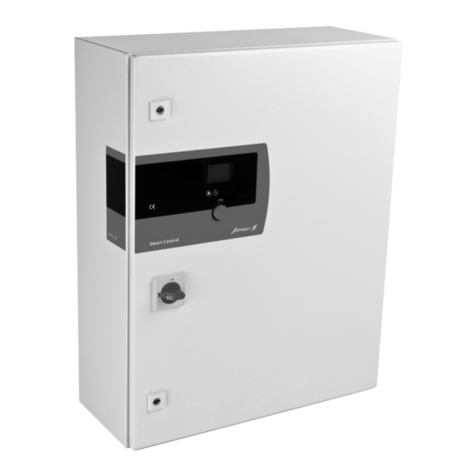
salmson
salmson SC-L Installation and starting instructions

Scantech
Scantech MA Series Operation manual
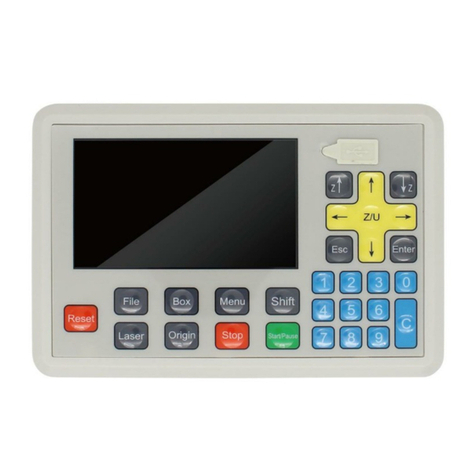
Trocen
Trocen AWC708C Plus user manual
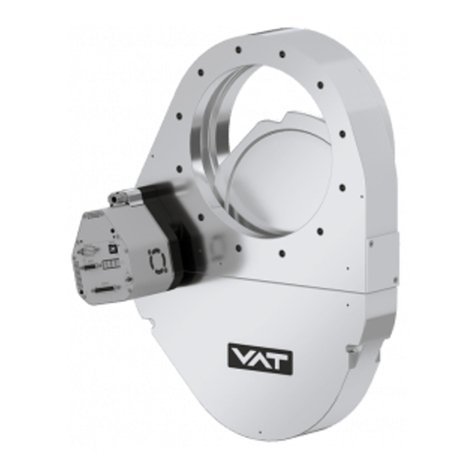
VAT
VAT 653 Series Installation, operating, & maintenance instructions
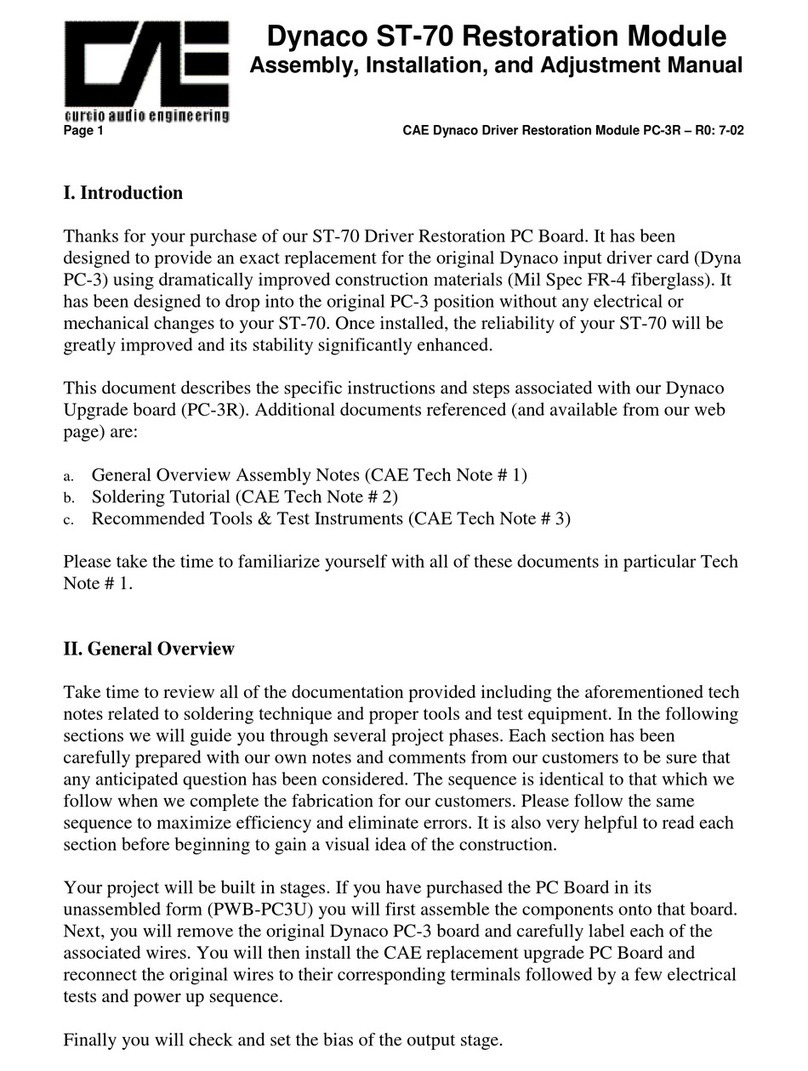
CAE
CAE Dynaco ST-70 Restoration Module Assembly, installation and adjustment Manual

